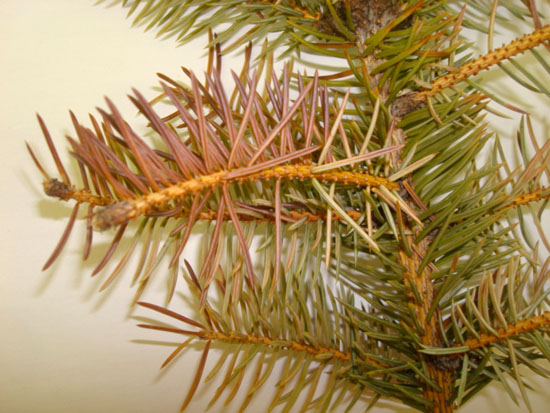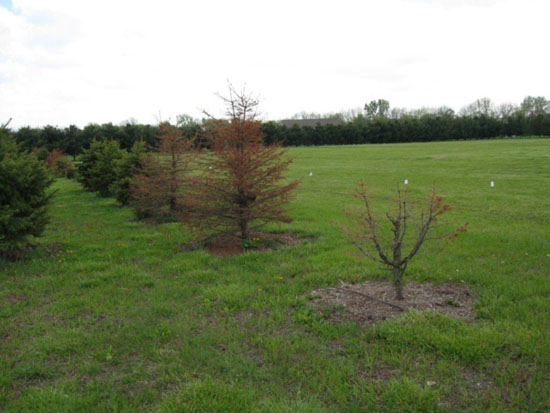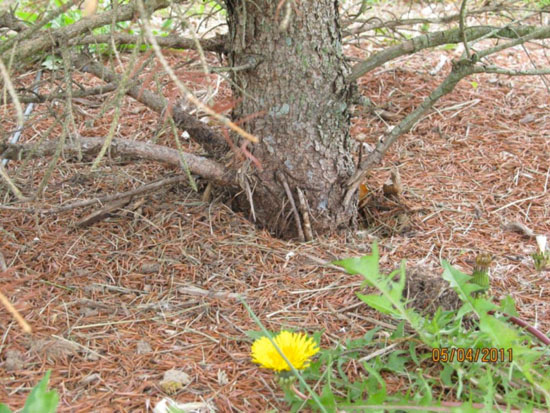Issue 4, May 17, 2011
More on Stressed Spruce and Deep Planting
The U of I Plant Clinic continues to receive many spruce samples. These samples are examined and evaluated for disease, insects, and mites. The bulk of the recent samples, however, have not yielded a biotic cause of decline.

This is a spruce sample that did not contain any fungal pathogen infection or signs of insect or mite damage.
Our next step is usually to evaluate the branch tip growth. The idea is to look at stem growth in length over several years. The terminal bud each year leaves a scar on the stem, seen as multiple rings around the stem, as if a rubber band had been tightly wrapped at that point. Distance between terminal bud scars from two successive years is the amount of growth for that year. Multiple years of 1 to 2 inches of stem growth clearly indicate a stressed tree.
Stress can be from overcrowding, deep planting, poorly drained soil, water stress over the past year, and even salt injury, depending on the site. Keep an open mind and check into these possibilities when determining the cause of your tree's decline. This becomes a very frustrating situation for the diagnosticians as well as our client.
We can only assume that the spruce is under some sort of stress, but we are not able to determine what is causing the problem in our lab. Unfortunately, we cannot visit the planting site. Many times we depend upon pictures to help give us an idea of any environmental problems that may be causing spruce decline.

In the case of this spruce sample, we received some awesome pictures. Here were the pictures that led to the diagnosis of deep planting.

Deep planting is when a tree or shrub is planted too deeply, the lower stem is placed below the soil and gaseous exchanges cannot occur freely through the bark. This condition does not immediately kill the plant. Decline may occur for many years before the plant passes the point of no return. Once the bark begins to fall from the trunk, the end is near. A similar slow decline may occur when mulch is mounded around the base of a tree.

In order to determine if your tree is planted too deep you will need to locate the first major root coming off the trunk. It should be at or just below the soil line. A flare of the trunk should be visible above the soil line. The trunk should not be the same width at the soil line as it is 4' up the trunk. It is really a pretty simple concept: roots are below ground and everything else is above the ground.
Does a tree that is planted too deeply need to be removed? That is not usually the case, but arborists can help the tree grow better. Deep planting is a major problem in our landscapes and one that is completely avoidable.
The International Society of Arboriculture (ISA) created www.treesaregood.com to provide quality information on tree care to the public. A section on planting new trees explains the planting process and has a helpful diagram to illustrate major points. One crucial mistake often made in planting is placing the root ball in the soil exactly as it comes from the nursery. Because nurseries use cultivation to cut down on weeds (and avoid herbicides), and because cultivation often throws soil up around the base of the tree, some of this soil may need to be removed before planting. Identify the trunk flare (where the roots cause the trunk to widen) and be certain this flare is partially visible when the tree is planted. The tree should be planted so the first root is just below the soil surface. Do not bury this flare with mulch once the tree is planted. Other details--such as digging the correct hole, mulching, and follow-up care--are discussed on the ISA Website. Taking the time to plant your tree correctly can help ensure a healthy tree for many years to come. Deep planting only causes years of tree decline and frustration in tree care. (Stephanie Porter)
Author:
Stephanie Porter